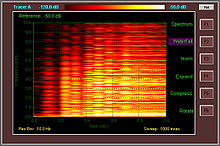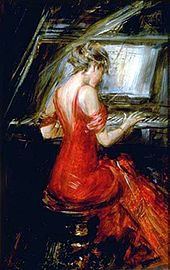Music 5
Texture
Main article: Texture (music)
Musical texture is the overall sound of a piece of music or song. The texture of a piece or song is determined by how the melodic, rhythmic, and harmonic materials are combined in a composition, thus determining the overall nature of the sound in a piece. Texture is often described in regard to the density, or thickness, and range, or width, between lowest and highest pitches, in relative terms as well as more specifically distinguished according to the number of voices, or parts, and the relationship between these voices (see common types below). For example, a thick texture contains many 'layers' of instruments. One layer can be a string section or another brass. The thickness is affected by the amount and the richness of the instruments.[97] Texture is commonly described according to the number of and relationship between parts or lines of music:
- monophony: a single melody (or "tune") with neither instrumental accompaniment nor a harmony part. A mother singing a lullaby to her baby would be an example.
- heterophony: two or more instruments or singers playing/singing the same melody, but with each performer slightly varying the rhythm or speed of the melody or adding different ornaments to the melody. Two bluegrass fiddlers playing the same traditional fiddle tune together will typically each vary the melody by some degree and each add different ornaments.
- polyphony: multiple independent melody lines that interweave together, which are sung or played at the same time. Choral music written in the Renaissance music era was typically written in this style. A round, which is a song such as "Row, Row, Row Your Boat", which different groups of singers all start to sing at a different time, is an example of polyphony.
- homophony: a clear melody supported by chordal accompaniment. Most Western popular music songs from the 19th century onward are written in this texture.
Music that contains a large number of independent parts (e.g., a double concerto accompanied by 100 orchestral instruments with many interweaving melodic lines) is generally said to have a "thicker" or "denser" texture than a work with few parts (e.g., a solo flute melody accompanied by a single cello).
Timbre
Main article: Timbre Spectrogram of the first second of an E9 suspended chord played on a Fender Stratocaster guitar. Below is the E9 suspended chord audio:
Spectrogram of the first second of an E9 suspended chord played on a Fender Stratocaster guitar. Below is the E9 suspended chord audio:
Duration: 13 seconds.
0:13
Timbre, sometimes called "color" or "tone color" is the quality or sound of a voice or instrument.[98] Timbre is what makes a particular musical sound different from another, even when they have the same pitch and loudness. For example, a 440 Hz A note sounds different when it is played on oboe, piano, violin, or electric guitar. Even if different players of the same instrument play the same note, their notes might sound different due to differences in instrumental technique (e.g., different embouchures), different types of accessories (e.g., mouthpieces for brass players, reeds for oboe and bassoon players) or strings made out of different materials for string players (e.g., gut strings versus steel strings). Even two instrumentalists playing the same note on the same instrument (one after the other) may sound different due to different ways of playing the instrument (e.g., two string players might hold the bow differently).
The physical characteristics of sound that determine the perception of timbre include the spectrum, envelope, and overtones of a note or musical sound. For electric instruments developed in the 20th century, such as electric guitar, electric bass and electric piano, the performer can also change the tone by adjusting equalizer controls, tone controls on the instrument, and by using electronic effects units such as distortion pedals. The tone of the electric Hammond organ is controlled by adjusting drawbars.
Expression
Expressive qualities are those elements in music that create change in music without changing the main pitches or substantially changing the rhythms of the melody and its accompaniment. Performers, including singers and instrumentalists, can add musical expression to a song or piece by adding phrasing, by adding effects such as vibrato (with voice and some instruments, such as guitar, violin, brass instruments, and woodwinds), dynamics (the loudness or softness of piece or a section of it), tempo fluctuations (e.g., ritardando or accelerando, which are, respectively slowing down and speeding up the tempo), by adding pauses or fermatas on a cadence, and by changing the articulation of the notes (e.g., making notes more pronounced or accented, by making notes more legato, which means smoothly connected, or by making notes shorter).
Expression is achieved through the manipulation of pitch (such as inflection, vibrato, slides etc.), volume (dynamics, accent, tremolo etc.), duration (tempo fluctuations, rhythmic changes, changing note duration such as with legato and staccato, etc.), timbre (e.g. changing vocal timbre from a light to a resonant voice) and sometimes even texture (e.g. doubling the bass note for a richer effect in a piano piece). Expression therefore can be seen as a manipulation of all elements to convey "an indication of mood, spirit, character etc."[99] and as such cannot be included as a unique perceptual element of music,[100] although it can be considered an important rudimentary element of music.
Form
See also: Binary form, Ternary form, and Development (music) Sheet music notation for the chorus (refrain) of the Christmas song "Jingle Bells" Jingle Bells refrain vector.midⓘ
Sheet music notation for the chorus (refrain) of the Christmas song "Jingle Bells" Jingle Bells refrain vector.midⓘ
In music, form describes the overall structure or plan of a song or piece of music,[101] and it describes the layout of a composition as divided into sections.[102] In the early 20th century, Tin Pan Alley songs and Broadway musical songs were often in AABA thirty-two-bar form, in which the A sections repeated the same eight bar melody (with variation) and the B section provided a contrasting melody or harmony for eight bars. From the 1960s onward, Western pop and rock songs are often in verse-chorus form, which comprises a sequence of verse and chorus ("refrain") sections, with new lyrics for most verses and repeating lyrics for the choruses. Popular music often makes use of strophic form, sometimes in conjunction with the twelve bar blues.[103]
In the tenth edition of The Oxford Companion to Music, Percy Scholes defines musical form as "a series of strategies designed to find a successful mean between the opposite extremes of unrelieved repetition and unrelieved alteration."[104] Examples of common forms of Western music include the fugue, the invention, sonata-allegro, canon, strophic, theme and variations, and rondo.
Scholes states that European classical music had only six stand-alone forms: simple binary, simple ternary, compound binary, rondo, air with variations, and fugue (although musicologist Alfred Mann emphasized that the fugue is primarily a method of composition that has sometimes taken on certain structural conventions.[105])
Where a piece cannot readily be broken into sectional units (though it might borrow some form from a poem, story or programme), it is said to be through-composed. Such is often the case with a fantasia, prelude, rhapsody, etude (or study), symphonic poem, Bagatelle, impromptu or similar compostion.[106] Professor Charles Keil classified forms and formal detail as "sectional, developmental, or variational."[107]
Philosophy
Main article: Philosophy of music The Woman in Red by Giovanni Boldini
The Woman in Red by Giovanni Boldini
The philosophy of music is the study of fundamental questions regarding music and has connections with questions in metaphysics and aesthetics. Questions include:
- What is the definition of music? (What are the necessary and sufficient conditions for classifying something as music?)
- What is the relationship between music and mind?
- What does music history reveal to us about the world?
- What is the connection between music and emotions?
- What is meaning in relation to music?
In ancient times, such as with the Ancient Greeks, the aesthetics of music explored the mathematical and cosmological dimensions of rhythmic and harmonic organization. In the 18th century, focus shifted to the experience of hearing music, and thus to questions about its beauty and human enjoyment (plaisir and jouissance) of music. The origin of this philosophic shift is sometimes attributed to Alexander Gottlieb Baumgarten in the 18th century, followed by Immanuel Kant. Through their writing, the ancient term 'aesthetics', meaning sensory perception, received its present-day connotation. In the 2000s, philosophers have tended to emphasize issues besides beauty and enjoyment. For example, music's capacity to express emotion has been foregrounded. [108]
In the 20th century, important contributions were made by Peter Kivy, Jerrold Levinson, Roger Scruton, and Stephen Davies. However, many musicians, music critics, and other non-philosophers have contributed to the aesthetics of music. In the 19th century, a significant debate arose between Eduard Hanslick, a music critic and musicologist, and composer Richard Wagner regarding whether music can express meaning. Harry Partch and some other musicologists, such as Kyle Gann, have studied and tried to popularize microtonal music and the usage of alternate musical scales. Modern composers like La Monte Young, Rhys Chatham and Glenn Branca paid much attention to a scale called just intonation.[109][110][111]
It is often thought that music has the ability to affect our emotions, intellect, and psychology; it can assuage our loneliness or incite our passions. The philosopher Plato suggests in The Republic that music has a direct effect on the soul. Therefore, he proposes that in the ideal regime music would be closely regulated by the state (Book VII).[112] In Ancient China, the philosopher Confucius believed that music and rituals or rites are interconnected and harmonious with nature; he stated that music was the harmonization of heaven and earth, while the order was brought by the rites order, making them extremely crucial functions in society.[113]

































